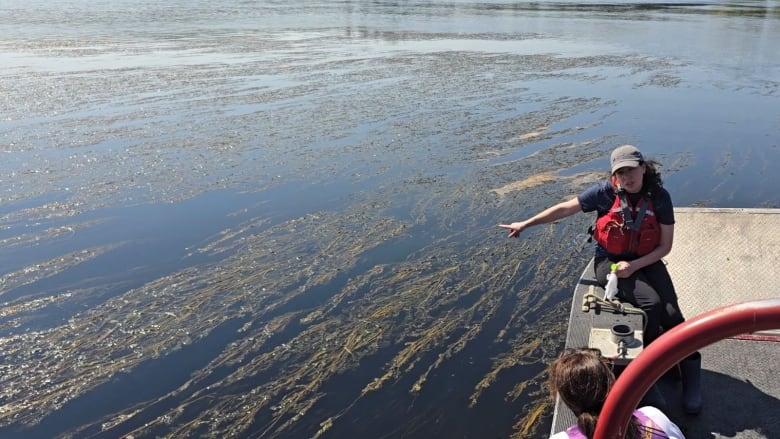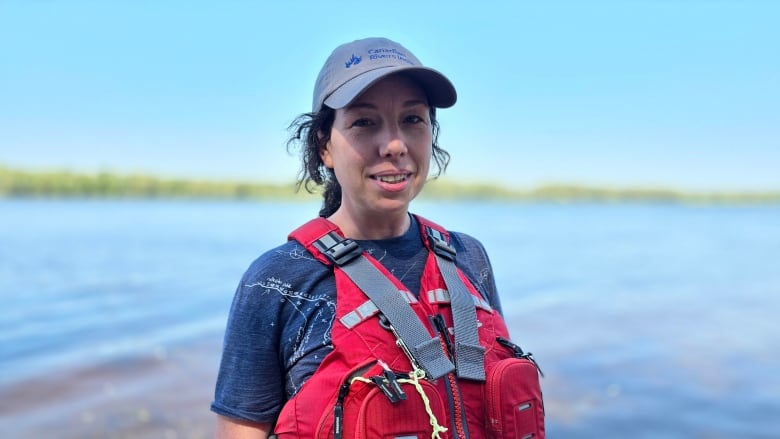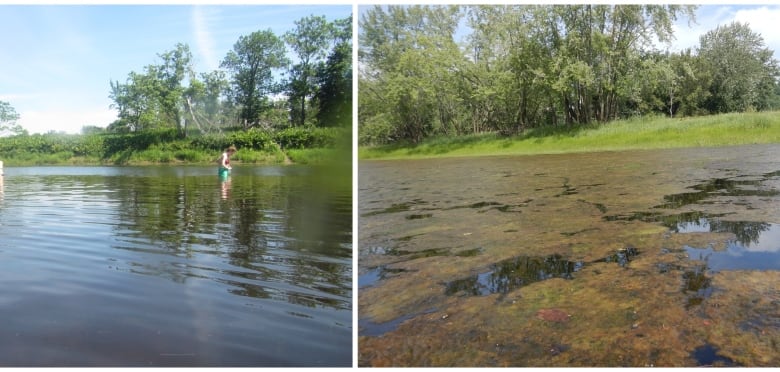Invasive zombie plant takes hold in St. John River
Local watershed group trying to manage spread of Eurasian watermilfoil

When aquatic botanist Meghann Bruce found an invasive species nicknamed zombie plant in the St. John River in 2015, she only found it in one spot.
She actually stumbled upon Eurasian watermilfoil while doing a botanical survey of the river for another project.
As part of that study, she explored 171 sites between the MactaquacDam and the Princess Margaret Bridge in Fredericton.
She returned to the same sitesin 2018 and discovered the invasive plant in more than 60 of the locations.

Bruce hasn't checked all of those sites since then, but she's regularly on the water in those areas and suspects the Eurasian watermilfoil has spread even further.
"It's not that surprising because it is an invasive speciesand one thing that they tend to have is a broad environmental tolerance,and so they tend to grow really well in new areas that they're introduced to."
As with many invasive species, now that Eurasian watermilfoil has established itself in the river system, "eradication is not feasible," said Bruce.
One local group, however, isn't willing to go down without a fight.
The Jemseg Grand Lake Watershed Association launched a pilot project last year to try to keep the plantat bay.The goal is to slow the spread and reduce the number of plants in some heavily affected areas.
Last fall, theteam divided an affected area into three zones, explained project co-ordinator Juan Sanchez.
In one, they used scissors to snip off the plants at ground level. In another, they pulled up the plants by hand roots and all. And the third area was left alone as a control site.

In the first two areas, they removed all of the zombie plantsand anything that looked like them, including native watermilfoils, just to be sure they got it all.
Sanchez returned to the areathis year and counted every single plant in all three sites.
Where they snipped the intruderswith scissors, he found 30-40 plants roughly the same numberfound last year but where they pulled the plants by the roots, there were only five to 10.
As for the control area, said Sanchez, "Well, there was an accident with the control."
Last summer saw unusually high water levels, he said. With levels significantly lower this summer, "the control plot didn't have the necessary depth for the plant to grow it back again."

The Eurasian watermilfoilearned the nickname of zombie plant by being impossibly hard to kill. In fact, about the only condition it can't survive is lack of water, so this year's lower water levels prevented it from growing as it did last year in the control plot.
John Welsman, a board member of the Jemseg Grand Lake Watershed Association, said the goal of the pilot project was to learn about the plantand to try to manage its spread.
He said some property owners have tried their own methods to get rid of it.

"But they may not know that every one of these fragments that they may leave behind can become its own new plant. So ... we're basically advising people not to try removing this themselves."
Sanchez said they may continue the project and set up more test sites in different areas of the lake to see how successful the hand-removal method is "across different years."
'Dense mats of floating vegetation'
The New Brunswick Invasive Species Council describes the Eurasian watermilfoil as a species native to Europe, Asia, and Northern Africa, "that was introduced to North America in the 19th-century via ballast water or the aquarium trade."
It's become "widely distributed" across North America, which has resulted in "severe impacts on aquatic ecosystems including rapidly establishing and forming dense mats of floating vegetation that shade out native aquatic plants and reduce oxygen in the water, impacting fish and other species."

Even a small broken-off piece can root and grow a whole new plant, saidBruce. That's why it's important to clean off boats and other equipment when moving from one body of water to another.
The species particularly likes the conditions in lakes and ponds, where water often moves more slowly.
"We've got a lot of beautiful lakes in New Brunswick that are valued recreationally. And if this was to get into those those are the types of habitat where it could really expand and proliferate," she said.
"In the river, we do find that it's a little bit more picky about what areas it's colonizing. It does like the back channels and the inner island habitats and coves with slower moving waters."
But it's even growing in the often fast-moving water near the MactaquacDam, closer than Bruce would have expected.

Where it has established itself, it's really taken hold, she said.
"It's getting to the point where in some areas, it's totally displaced native species. Or in some spots, they're still growing, just not as abundant."
Bruce, who teaches at the University of New Brunswick, used to take students to a particular cove on the St. John River, above Fredericton, to teach them about plant identification. The cove included a variety of plant species, including two that occur in very few locations in the province.

"It was excellent because of the diversity in this area. And it is a really beautiful spot. And now when I go back there, it's all Eurasian watermilfoiland I can no longer find those two rare plants."
Bruce said the plants don't pose any real dangerto people, it's "mainly an inconvenience."
When the plants are thick enough, they interfere with recreational activities like fishing, swimming and boating.













_(720p).jpg)


 OFFICIAL HD MUSIC VIDEO.jpg)
.jpg)



























































































